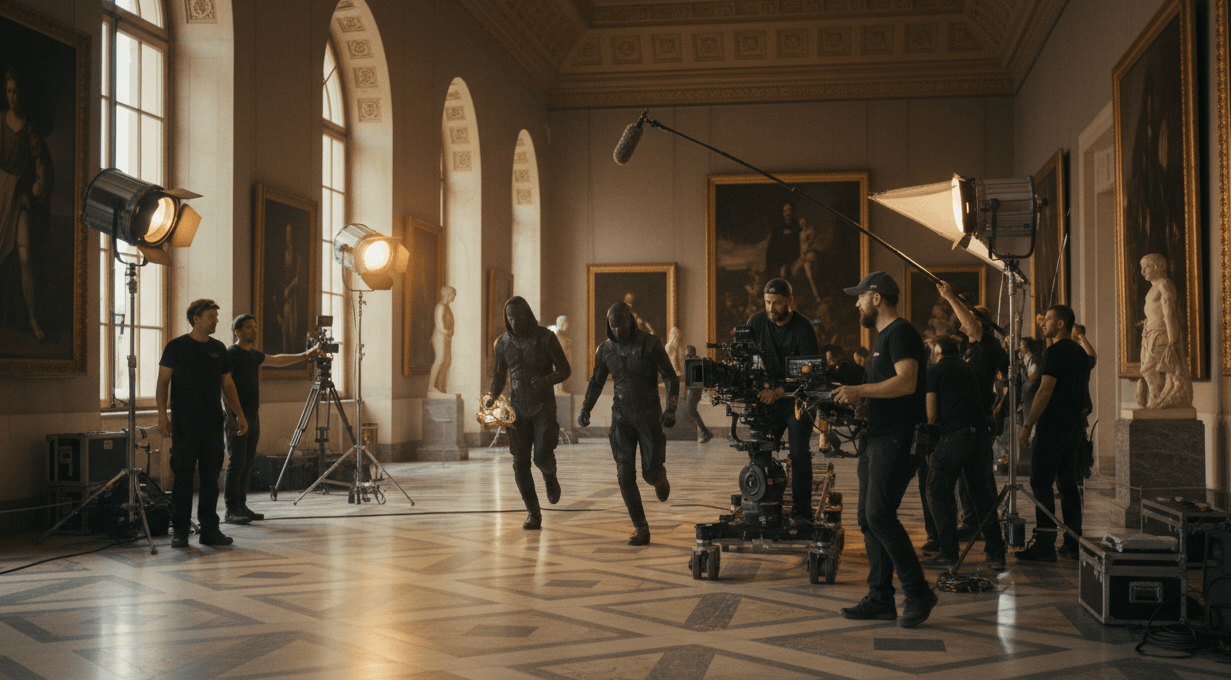When Real Heists Outsmart Movie Logic: The Louvre Caper vs Ocean’s Eleven (and the Best Museum-Theft Movies to Steal From)
Explore how the real October 19, 2025 Louvre heist echoes — and breaks — the rules of classic movie capers, from Rififi to Ocean’s Eleven. Compare the real and the reel, and dive into the best heist films that shaped our idea of the perfect crime.


Paris woke up to a real-life heist straight out of “Ocean’s Eleven” — four to seven minutes, glass smashed, jewels gone. We’re shocked… and kind of entertained by how “Danny Ocean-coded” it all feels. So, what actually lines up with the movies, what’s pure myth, and which heist flicks should you queue up next if you’re plotting your own cinematic caper?
💥 Cold-open: The Day Paris Blinked
On Sunday morning, October 19, 2025, four masked thieves in hi-viz workwear pulled off a scene straight out of a heist movie. Using a truck-mounted basket lift, they reached a window on the Louvre’s riverfront side, forced their way into the Galerie d’Apollon, smashed display cases, and sped off on motorbikes with eight pieces of French crown jewelry.
One 19th-century crown linked to Empress Eugénie didn’t make the getaway — it was dropped and later recovered, damaged but intact. The famed Regent diamond, mercifully, wasn’t touched.
The break-in happened after opening hours, with visitors still inside. Alarms, confusion, evacuation — then the Louvre went dark as police launched a manhunt. Days later, the thieves are still at large, and investigators are tracing security footage, witness accounts, and fragments of evidence left behind.
If all of this sounds a little too cinematic — it is. The precision timing, the disguises, the perfectly chosen target—it’s pure heist movie energy. Only this time, there’s no George Clooney smirking behind the plan, no jazzy montage of blueprints and espresso shots. Just real thieves, real jewels, and a very real headache for French police.
Still, it’s hard not to think of the greats: “Ocean’s Eleven,” “Inside Man,” “The Italian Job,” “Rififi,” — films that made us root (just a little) for the bad guys and fall in love with the choreography of crime. So let’s unpack what this Louvre operation actually shares with Hollywood’s slickest capers, what it definitely doesn’t, and which heist films are worth another watch tonight.
🎬 “Ocean’s Eleven” (2001)
The blueprint for every “cool” heist since 2001. Clooney, Pitt, and their perfectly dressed crew turn crime into choreography — all charm, jazz, and precision timing. What makes it timeless isn’t the robbery itself but the mood: calm minds under chaos, friendship, and that smug smile when the plan clicks. The Louvre thieves clearly took notes — minus the tuxedos and the Vegas skyline.
🖤 “Rififi” (1955)
The silent masterclass. Jules Dassin’s noir classic features a 30-minute robbery sequence with zero dialogue — just the sound of tension breathing. No gadgets, no CGI, just men, ropes, and focus. It’s the film every modern heist imitates without even knowing it. If the Louvre crew had any cinema taste, this was their bedtime story.
🔥 “Heat” (1995)
Michael Mann’s bullet-and-sweat opera. De Niro vs Pacino — two perfectionists circling each other across Los Angeles. “Heat” isn’t about the score; it’s about obsession, discipline, and what it costs to be that good. The Louvre job had the same tempo: timed, clean, impersonal — except in real life, there’s no soundtrack to make the panic poetic.
🧩 “Inside Man” (2006)
Spike Lee’s brainy twist on the genre — a bank heist that’s really a moral puzzle. Clive Owen’s calm, calculating ringleader turns confinement into freedom and power into irony. Like the Louvre case, it’s as much about symbolism as loot. Both play with the idea of visibility: doing something spectacular in plain sight and disappearing before anyone understands how.
🕶️ “The Thomas Crown Affair” (1999)
If art theft had a dress code, this would be it. Pierce Brosnan steals paintings (and hearts) with impossible grace, while Rene Russo tries to catch him — in every sense. It’s flirtation disguised as crime. After the Louvre chaos, Crown’s composure feels almost nostalgic — like a fantasy of elegance in a world that now breaks glass instead of rules.
🚗 “The Italian Job” (1969 / 2003)
Two versions, same irresistible charm. Whether it’s Michael Caine’s cheeky British cool or Mark Wahlberg’s sleek modern remake, “The Italian Job” nails the balance of style, speed, and teamwork. Mini Coopers darting through tunnels became a pop-culture icon of precision chaos. The Louvre gang, by comparison, ditched the cars for motorbikes — same energy, fewer quips.
🗝️ “The Bank Job” (2008)
Based on a true London robbery that uncovered more than money — kompromat, scandals, and royal secrets. Gritty, tense, and refreshingly un-glamorous. It reminds us that the line between political thriller and heist film is razor-thin. The Louvre thieves probably dreamed of that kind of payoff, but the only thing they unlocked was an international manhunt.
🎓 “American Animals” (2018)
Four college students think they can steal rare books from their university library — and film it. Spoiler: they can’t. The movie mixes real interviews with reenactments, blurring truth and delusion. It’s the anti-“Ocean’s Eleven”: awkward, anxious, human. Watching it after the Louvre incident feels like peeking behind the myth — this is what happens when fantasy meets reality head-on.
🖼️ “How to Steal a Million” (1966)
Light, stylish, and deliciously caper-y — Audrey Hepburn and Peter O’Toole pull off art-world misdirection with wit. It’s a romantic romp where forgery meets flirtation; theft is practically a gentlemanly pastime. After the Louvre smash-and-grab, this one reads like the genre’s pastel-colored daydream — charming, improbable, and lovely to watch.
🧭 “National Treasure” (2004)
Part Indiana Jones, part treasure-hunt buddy comedy. Nicolas Cage turns conspiracy into family-friendly spectacle: clues, maps, and history-as-puzzle. It’s less about slick robberies and more about quest logic — but it’s pure fun, and it reminds us how irresistible the idea of a “hidden national secret” can be. Perfect if you want your heist with a side of patriotic myth.
🕵️ “Entrapment” (1999)
Cat-and-mouse with a glossy sheen — Sean Connery and Catherine Zeta-Jones spar over trust, betrayal, and gravity-defying capers. “Entrapment” sells the seduction of planning and the moral fog that comes with it. Watch it for the twists, the rooftop set pieces, and the way it makes procedural cunning feel like a dangerous tango.
Key ingredients for a better heist (in movies, of course)
A great heist isn’t just about what’s stolen, but how it’s done. Whether it’s Mini Coopers racing through tunnels, Audrey Hepburn sneaking through a Paris museum, or Clooney’s crew bluffing their way past lasers and guards, the thrill is in the craft. If you’re wondering what makes a movie heist actually work, here’s what every great one has in common:
- 💡 A clean, visual plan — blueprints, rehearsals, a single elegant gimmick. The more the audience can see the plan, the more satisfying the payoff.
- 👥 A defined role for every player — the driver, the safecracker, the charmer, the inside voice. Distinct roles turn chaos into choreography.
- ⏰ A clock — a hard deadline or ticking timer keeps tension honest. Deadlines make clean cinema.
- ⚖️ A moral twist — ambiguity or a motive that complicates rooting for the thieves. Sympathy (or its absence) gives the audience something to argue about at the bar.
- 🎭 Aesthetic flair — costumes, music, and mise-en-scène that make the crime feel stylish, not just criminal. Mood is the heist’s soul.
- 💥 A believable vulnerability — small mistakes, human panic, or unexpected witness moments that keep the stakes real. Perfection is boring; friction is riveting.
- 🛵 An inventive getaway — it can be a tunnel, motorbikes, or misdirection; the escape should feel inevitable and clever.
- 🎬 A payoff that earns its setup — whether it’s a moral reveal, a political sting, or a pure adrenaline jolt, the final twist should feel earned, not cheap.
When life imitates art (a little too well)
The Louvre job reminded us how thin the line can be between spectacle and scandal — how easily a real crime can mirror a movie scene. Still, on screen, it’s where we’d rather keep it: clever, stylish, and safely fictional. Because in cinema, the jewels always shine again. In reality, once they’re gone, they’re gone.
Planning your own on-screen caper?
Use Filmustage to break down your script, tag your scenes, build a shooting schedule, and estimate your budget with AI precision — so your next heist story stays thrilling (and completely legal).
From Breakdown to Budget in Clicks
Save time, cut costs, and let Filmustage’s AI handle the heavy lifting — all in a single day.